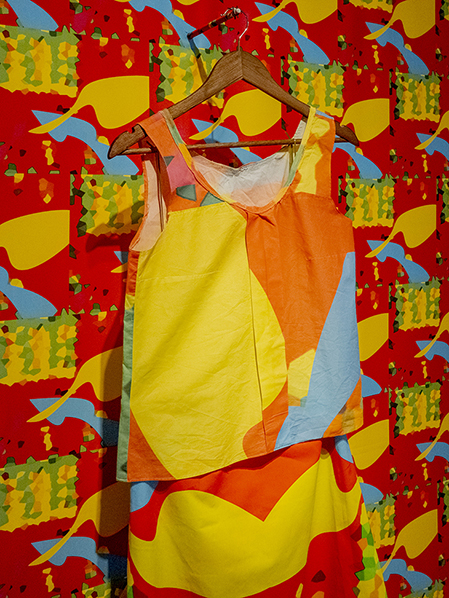
Continuing through February 20, 2022
Following on a fleet of prestige museum shows, regional awards and highly engaged coverage, Molly Vaughan’s “Project 42” is the high point of her career — so far. Still only 45 (younger if you count only the years she’s been a transgendered person), her “Project 42” astounds contemporary art fans who wonder, “How can a subject so horrible — the murders of 42 transgendered women of color — be represented in so many different ways: fashion show, performance art, multi-media sculpture — and somehow rise above its gruesome memorial mission?” Earlier versions were shown in smaller venues, but BIMA curators Amy Sawyer and Greg Robinson gave the Bellevue College art professor a chance to create a career milestone: the shift from inkjet-printed paper as a dress material to screen- and computer-printed fabric.
More dress-like and thus more convincing, for 21 of the 42 victims here, the material transition has made all the difference. The new works, some of which are accompanied by photo-documents of earlier events and a “vogueing” video of Vaughan’s cast in clothing, gleam with bright color, it all celebrates the lives, cities and towns of their rise and demise. Presented on hangers against backdrops of matching material, the double-take effect of funereal relics or elegant storefront window display is confounding and entertaining at the same time.
True to her mission, Vaughan researched all 42 lives and uses their individual circumstances — geographical and otherwise — as sources for the look of the patterned material. Take another look: each pattern is based on a Google map of the locale of the given murder; both seam and scene of the crime are co-present, intensifying the viewer’s slow burn of sadness and recognition. The artist’s goal of increasing viewer “awareness of these issues through active accomplice creation rather than ally creation” is more than fulfilled as is her hope that “viewers will actively engage in their own research and by doing so, increase their connection with this complex issue.”
Instead of being seated at the de rigueur haute couture runway show in some industrial factory or obscure chateau, an art museum is used to memorialize innocent men and women by displaying garments that echo some of the most famous clothing designers of the past century. These are sculptures of dresses which can be worn in performances; they are not real dresses, however.
This is an exhibit for compulsive clothing shoppers as well as art mavens. Such visitors will outguess historical sources with one another only to realize that each collar, décollage or pajama pant is tied to a year, a season, an event, an identifying garment that becomes, on second glance, a shroud. Vaughan, born in London, retains a flair for pop clothing, Carnaby Street, and the attire of the so-called tatterdemalions, raggedy looking teenagers who affected torn clothing and pigtails long before Kurt Cobain or Miley Cyrus. As a result, there is a short shelf-life look to the extremes of color, pleating, enrobing and revealing that shout Vivien Westwood and Alexander McQueen just as surely as Dior, Balenciaga or the late African-American designer darling of Paris, Patrick Kelly.
Vaughan’s fully aproned and skirt-trained “Lorena Escalera Xtravaganza, 43 Furman Avenue in Bushwick, Brooklyn, NY” recalls another Englishman, Anglo-Nigerian sculptor Yinka Shonibare, CBE, whose padded mannequins of slave girls wearing Victorian tartans, won him the Turner Prize and a gigantic following. With luck and follow-through, Vaughan could match him with her fiercely elegant assemblages and dangerous undertones of violence and resilience. Jewelry is joined by scarves; faded newsprint turns into lace before our eyes. “Brandy Martell. . . Oakland, CA” is resurrected with a short skirt wrapped in torn fabric shards with long sleeves and long rows of shredded silk ribbons.
Equally loaded in its symbolic implications, “Camilla Guzman. . . NYC, NY” was worn by Vaughan at a performance in Tulsa, Oklahoma, site of the 1921 Greenwood District massacre of African-Americans. Tellingly, Vaughan’s sleeveless shift uses yellow roadside “DANGER” signs as a pattern motif for the accompanying backdrop and dress material. In “Project 42,” the effigies of twenty-one women become our focus of grief and community mourning, both within the art museum and out on the street, hopefully one now more sensitive to sharing public space and zones of safety with this growing minority who continue to live bravely and proudly.
